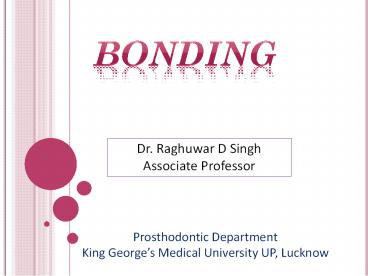BONDING PowerPoint PPT Presentation
Title: BONDING
1
BONDING
Dr. Raghuwar D Singh Associate Professor
Prosthodontic Department King Georges Medical
University UP, Lucknow
2
ADHESION
- Sound tooth structure must be conserved.
- Optimal retention must be achieved.
- Microleakage must be prevented.
3
MECHANISM OF ADHESION
- Factors in achieving adhesive bonds
- Wetting
- Interpenetration (formation of a hybrid zone)
- Micromechanical Interlocking
- Chemical bonding
4
ACID ETCHING TECHNIQUE
- Most effective ways of improving the marginal
seal - mechanical bonding b/w Resin and Enamel .
- Mode Of Action
- It creates micro-porosities by etching of the
enamel .
5
- Etching increase the surface area .
- Etched enamel has a high surface energy and
allows a - resin to wet the surface penetrate into
micro- - porosities.
- Resin Tags are approx 6microm in diameter and
10-20micro m in length.
6
- Acid Used
- 37 Phosphoric acid is most commonly used acid
. - Supplied in gel form .
- Brush or Syringe is used for application on the
- enamel .
7
- Procedure
- Dry the enamel surface completely .
- Length of application 60 sec.
- but may be 15 sec.
- After etching , dried enamel shows white ,
frosted - appearance .
- If enamel surface is contaminated, re-etching
for 10 sec .
8
BONDING AGENTS
- Enamel bond agents
- Dentin bond agents
9
ENAMEL BOND AGENTS
- Hydrophobic
- Unfilled resin
- Bis GMA
- TEGDMA
10
DENTIN BOND AGENTS
Dentin
11
Problems in bonding to dentin
- Dentin is a dynamic tissue that shows changes due
to ageing, caries or restorative procedures. - Dentinal tubules are filled with dentinal fluid
which constantly flow outward from the pulp. - Dentin has considerable amount of organic
material water. - Dentin is close to pulp, so different chemical
used for bonding and etching may irritate the
pulp.
12
role of smear layer -
- Whenever tooth surface is cut with hand or rotary
instruments, it causes small particles of the cut
tooth surface to the tooth producing the smear
layer. - Smear layer is defined as any debris, calcific in
nature produced by reduction or instrumentation
of enamel of dentin or cementum.
13
- Retention of smear layer-
- 1) lowers dentin permeability
- 2) prevent decrease in bond strength
- 3) lowers effect of pulpal pressure on bond
strength - Recent generations adhesives involves
modification of smear layer to facilitate bonding.
14
- It has two phases -
- Solid phase- made up of cutting debris, primarily
- denaturated collagen and
mineral. - Liquid phase- made up of tortuous fluid filled
channels - around the cutting
debris. - Bacteria entrapped in smear layer can survive and
multiply beneath the restoration.
15
Conditioning of dentin
- It is defined as an alteration of dentin surface
including the smear layer with the objective of
producing a substrate capable of micromechanical
and possibly chemical bonding to dentin adhesive. - Acid conditioners
- Phosphoric acid,
- Citric acid,
- Nitric acid,
- Oxalic acid, and
- Hydrochloric acid.
16
- Chelators-
- Remove the smear layer without
decalcification or significant physical changes
on underlying dentin substrate. - Best known chelator conditioner is EDTA.
- Thermal conditioning-
- Recent trend is to use lasers in conditioning
of teeth. - Studies have conformed increased bond strengths
with lased dentin compared to those with unlased
dentin.
17
- The molecule designed for dentin bonding were
represented by an M-R-X molecule. - M- methacrylate group for bonding to resin matrix
of composite resin - R- spacer such as hydrocarbon chain
- X- functional group for bonding to organic or
inorganic component of dentin.
18
ETCHENTS / CONDITIONERS
- ORGANIC ACID- Maleic acid, EDTA, Citric acid,
- Tartaric acid.
- POLYMERIC ACID- Poly acrylic acid.
- INORGANIC ACID- Phosphoric acid, Nitric acid.
19
- Hydrophilic
Primers/ Conditioners
Bonding liquid
20
PRIMERS
- NTG-GMA
- PMDM
- BPDM
- PENTA
- HEMA
21
ADHESIVE RESINS
- Hydrophobic monomers -
- BIS-GMA
- UDMA
- Diluent -
- TEGDMA
- Wetting agent -
- HEMA
22
DENTIN BONDING AGENTS
- First generation
- Second generation
- Third generation
- Forth generation
- Fifth generation
23
MCQs
- Most effective way of improving the marginal seal
and bonding between restorative resin and Enamel
is - 1. Using adhesive
- 2. Acid etching
- 3. Using both adhesive and acid etching
- 4. None of the above
24
- Most commonly used acid for acid etching
technique - 1. 35 Phosphoric acid
- 2. 37 Phosporic acid
- 3. 37 Hydrochoric acid
- 4. 35 Citric acid
25
- Chelators most commonly used to remove the smear
layer - 1. EDTA
- 2. BIS GMA
- 3. HEMA
- 4. Oxalic acid
26
- The nature of enamel bonding agents should be
- 1. Hydrophilic
- 2. Hydrophobic
- 3. Depending on the condition of enamel
- 4. Neutral
27
- The length of application of acid in acid etching
technique should be - 1. 10 Second
- 2. 60 Second
- 3. 90 Second
- 4. 120 Second
28
THANK YOU

